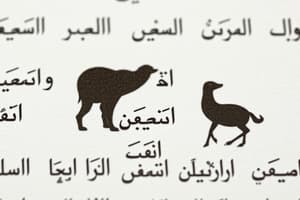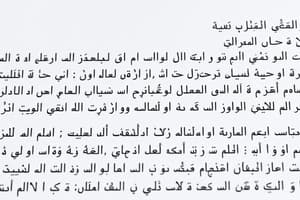Podcast
Questions and Answers
What is the primary language family of Arabic?
What is the primary language family of Arabic?
- Sino-Tibetan
- Afro-Asiatic (correct)
- Indo-European
- Romance
Modern Standard Arabic (MSA) is primarily used in casual conversations.
Modern Standard Arabic (MSA) is primarily used in casual conversations.
False (B)
Name one of the challenges faced when learning Arabic.
Name one of the challenges faced when learning Arabic.
Dialect differences, script complexity, or pronunciation
Arabic is written from __________ to left.
Arabic is written from __________ to left.
Match the following varieties of Arabic with their regions:
Match the following varieties of Arabic with their regions:
Which script variation is true about Arabic writing?
Which script variation is true about Arabic writing?
The root system in Arabic allows for extensive word formation.
The root system in Arabic allows for extensive word formation.
What is the liturgical language of Islam?
What is the liturgical language of Islam?
Flashcards are hidden until you start studying
Study Notes
Overview of Arabic
- Language Family: Semitic branch of the Afro-Asiatic family.
- Speakers: Over 400 million native speakers.
- Primary Regions: Middle East and North Africa.
Dialects
- Modern Standard Arabic (MSA): Formal, standardized language used in writing and formal speech.
- Dialects: Varieties include Egyptian, Levantine, Gulf, Maghrebi, and others; often mutually unintelligible.
Writing System
- Alphabet: Consists of 28 letters, written from right to left.
- Scripts: Cursive script with variations; the shape of letters changes based on their position in a word.
Phonetics
- Consonants: Emphasis on guttural and emphatic sounds; includes 3 "emphatic" consonants.
- Vowels: Short vowels are often not written; long vowels are represented in writing.
Grammar
- Noun Cases: Uses nominative, accusative, and genitive cases.
- Gender: Nouns are either masculine or feminine.
- Verb Conjugation: Verbs conjugate based on tense, mood, and subject.
Vocabulary
- Loanwords: Arabic has influenced numerous languages (e.g., Spanish, English).
- Root System: Most words are derived from a three-letter root; allows for extensive word formation.
Cultural Significance
- Religion: Arabic is the liturgical language of Islam; the Quran is written in Classical Arabic.
- Literature: Rich tradition including poetry, novels, and historical texts.
Global Influence
- Diaspora: Significant Arabic-speaking communities in Europe, America, and beyond.
- International Dialects: Arabic is one of the six official languages of the United Nations.
Learning Arabic
- Resources: Language courses, online platforms, and immersion programs available.
- Challenges: Dialect differences, script complexity, and pronunciation may pose learning obstacles.
Overview of Arabic
- Language belongs to the Semitic branch of the Afro-Asiatic family.
- Spoken by over 400 million native individuals.
- Predominantly found in the Middle East and North Africa.
Dialects
- Modern Standard Arabic (MSA) serves as the formal, standardized language for writing and formal communication.
- Various dialects include Egyptian, Levantine, Gulf, and Maghrebi, many of which are not mutually intelligible.
Writing System
- Arabic alphabet contains 28 letters and is written from right to left.
- The cursive script features variations; letter shapes change depending on their position within a word.
Phonetics
- The language emphasizes guttural and emphatic sounds, with three specific "emphatic" consonants.
- Short vowels are often omitted in writing, whereas long vowels are explicitly represented.
Grammar
- Arabic utilizes three noun cases: nominative, accusative, and genitive.
- Nouns are categorized as masculine or feminine, impacting their conjugation and agreement.
- Verbs are conjugated considering tense, mood, and the subject involved.
Vocabulary
- Arabic has significantly influenced various languages, including Spanish and English, through its loanwords.
- The root system, primarily based on three-letter roots, facilitates the creation of numerous related words.
Cultural Significance
- Serves as the liturgical language of Islam, with the Quran written in Classical Arabic.
- Features a rich literary heritage, encompassing poetry, novels, and historical writings.
Global Influence
- Arabic-speaking communities are widely established across Europe, America, and other regions.
- Recognized as one of the six official languages of the United Nations.
Learning Arabic
- Various resources exist for learning, including language courses, online platforms, and immersive experiences.
- Challenges for learners include dialect diversity, complex script, and unique pronunciation features.
Studying That Suits You
Use AI to generate personalized quizzes and flashcards to suit your learning preferences.




